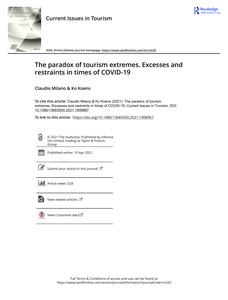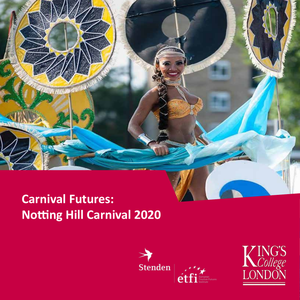This study proposes a framework to measure touristification of consumption spaces, consisting of concentration of retail capital, business displacement and standardization of the consumption landscape. This framework is tested using business registration data and rent price estimates for consumption spaces in Amsterdam between 2005 and 2020. Touristification emerges from concentrations of retail capital and standardization, but occurs without causing significant business displacement. A cluster analysis identifies different variations of touristification. Besides the more typical cases these include nightlife areas, gentrifying consumption spaces and specialized retail areas. This suggests that local contingencies cause consumption spaces to respond differently to increasing tourism.
DOCUMENT

This paper seeks to highlight underlying issues of the tourism system that have led to tourism extremes of too much or too little tourism. Five phases are recognized that reflect different ways of dealing with too much tourism over time, after which the impact of a sudden lack of tourism is investigated in light of future renewal processes. This discussion highlights the remarkable capacity of the tourism industry to adjust to rapidly changing circumstances and crises, even when these cause anguish to individuals and within societies at large. The paper thus seeks to contextualize the current discussions regarding the transformation of tourism post COVID-19. It highlights the complexity of changing a tourism that multiple stakeholders depend on or have grown accustomed to. To come to a more balanced tourism, it is necessary to not only come up with alternative visions and strategies, but also to engage with the political economy nature of tourism development. A future research agenda should therefore also discuss facets of entangled power, social exclusion, inequalities and class differences to come to new reference points of what actually constitutes a more inclusive tourism success.
MULTIFILE

Touristification of consumption spaces describes a process in which retail and hospitality businesses adapt to the tourist demand, eroding place attachment among local residents. While this is an important cause of resistance to tourism, little is known about the mechanisms that drive or mediate this process. We address this gap by interviewing entrepreneurs in Amsterdam. We found three distinct areas in close proximity where entrepreneurs responded to increasing tourism in markedly different ways; by crowd-pleasing, niche-playing and gentrifying. The resulting microgeographies of touristification of consumption spaces have not only been overlooked in literature, but also in urban policies. This causes a mismatch between the more generic, city-wide regulation and the highly differentiated effects of tourism on consumption spaces.
DOCUMENT

This paper seeks to highlight underlying issues of the tourism system that have led to tourism extremes of too much or too little tourism. Five phases are recognized that reflect different ways of dealing with too much tourism over time, after which the impact of a sudden lack of tourism is investigated in light of future renewal processes. This discussion highlights the remarkable capacity of the tourism industry to adjust to rapidly changing circumstances and crises, even when these cause anguish to individuals and within societies at large. The paper thus seeks to contextualize the current discussions regarding the transformation of tourism post COVID-19. It highlights the complexity of changing a tourism that multiple stakeholders depend on or have grown accustomed to. To come to a more balanced tourism, it is necessary to not only come up with alternative visions and strategies, but also to engage with the political economy nature of tourism development. A future research agenda should therefore also discuss facets of entangled power, social exclusion, inequalities and class differences to come to new reference points of what actually constitutes a more inclusive tourism success.
MULTIFILE
Carnival Futures: Notting Hill Carnival 2020 is a King’s Cultural Institute project led by Nicole Ferdinand (Culture, Media and Creative Industries at King’s College London) which sought to engage cultural organisations and other stakeholders in planning for the future of the Notting Hill Carnival. The content of this report is intended as a contribution to current research and to identifying future directions for the development of the Notting Hill Carnival. The material and views expressed are produced by various stakeholders in a series of workshops.
DOCUMENT

Vastgoed biedt onderdak aan activiteiten in de samenleving; aan wonen, werken, winkelen, zorgen, leren, ontspannen en ontmoeten. De manier waarop we invulling geven aan die activiteiten is voortdurend in beweging. Dit vormt een uitdaging voor het vastgoed, want stenen zijn van nature traag.De spanning tussen de dynamiek van maatschappelijke processen en het betrekkelijk statische karakter van het vastgoed wordt versterkt door de grote opgaven waar we als samenleving voor staan. Klimaatadaptatie, energietransitie, leefbaarheid, gezondheid en circulariteit: het zijn opgaven die stuk voor stuk raken aan de kwaliteit van onze leefomgeving. Maar óók aan de kwaliteit van de onderliggende systemen die deze ruimte produceren. En juist op dat punt is de vastgoedwereld aan zet.In deze lectorale rede roept Bart de Zwart, lector Vastgoed aan de Hanzehogeschool Groningen, op tot een andere manier van denken over en denken in het vastgoed. In die nieuwe denkwijze staan niet de stenen maar de mensen centraal. Het gaat dan onder meer over de vraag hoe we de bestaande voorraad duurzaam kunnen (her)gebruiken, hoe we kunnen inzetten op meervoudige waardencreatie voor gebruikers en de omgeving, en hoe we aandacht geven aan inclusiviteit en ethiek. Op die manier kan vastgoed als vakgebied niet alleen meebewegen met ontwikkelingen, maar onderdeel worden van de verandering.
DOCUMENT

This paper presents four Destination Stewardship scenarios based on different levels of engagement from the public and private sector. The scenarios serve to support destination stakeholders in assessing their current context and the pathway towards greater stewardship. A Destination Stewardship Governance Diagnostic framework is built on the scenarios to support its stakeholders in considering how to move along that pathway, identifying the key aspects of governance that are either facilitating or frustrating a destination stewardship approach, and the required actions and resources to achieve an improved scenario. Moreover, the scenarios and diagnostic framework support stakeholders to come together to debate and scrutinise how tourism is managed in a way that meets the needs of the destination, casting new light on the barriers and opportunities for greater destination stewardship.
DOCUMENT

In this policy evaluation report, the results of the first 2 years of the Interreg funded ABCitiEs project are presented. In total 16 entrepreneurship collectives have been studied in 5 partner regions, i.e. Athens, Vilnius, Varazdin-Cakovec, Manchester and Amsterdam. The report contains an analysis of the cases and gives an overview of the most important opportunities and challenges faced by these cases. On the basis of these result, 4 policy directions have been selected in which improvement are considered most successful, i.e. access to funding, intermediaries, monitoring and experimental learning environments. Also, the report presents the action plans that have been formulated on the basis of these policy directions for the cities involved in this project. In the last 2 years of the project, project partners will implement these action plans in their respective cities.
MULTIFILE

The development of ‘age-friendly cities’ has become a major area of work in the field of ageing and the built environment. This movement is driven by the observation that cities are home to an ever-increasing ageing population. Over the past decade, a multitude of age-friendly initiatives have been developed with the aim of making physical and social environments more favourable for older people's well-being, health and ability to live in the community. This article explores ten key questions associated with the age-friendly cities and communities' movement, with a particular focus on the built environment. It provides an overview of the history of the age-friendly cities' movement and the underlying models, the aspects of the built environment that are relevant for age-friendly cities, the ways age-friendliness can be evaluated, and the interactions between age-friendly cities initiatives and other strategic agendas such as smart cities. The paper concludes by discussing future perspectives and possible directions for further development of the age-friendly movement. © 2021 The Authors. Published by Elsevier Ltd. https://doi.org/10.1016/j.buildenv.2021.107922 LinkedIn: https://www.linkedin.com/in/jvhoof1980/
MULTIFILE

Comprehensive understanding of the merits of bottom-up urban development is lacking, thus hampering and complicating associated collaborative processes. Therefore, and given the assumed relevancies, we mapped the social, environmental and economic values generated by bottom-up developments in two Dutch urban areas, using theory-based evaluation principles. These evaluations raised insights into the values, beneficiaries and path dependencies between successive values, confirming the assumed effect of placemaking accelerating further spatial developments. It also revealed broader impacts of bottom-up endeavors, such as influences on local policies and innovations in urban development.
MULTIFILE
